History
Inspiring.Faith.Community.

Cathedral’s History…
The Story Continues
Who we are now is a result of our past. Our foundation. Our founding. We continue the tradition that is Cathedral. Learn about our past and know that there is more to come of our story!
History of the Cathedral Building

The First Cathedral – mid-1800s
READ MORE
Bishop O’Gorman eventually decided on Omaha City and took up residence on the southwest corner of Eighth and Harney streets. The little brick church standing across the street, as yet the only Catholic church in the entire territory of Nebraska, was consequently elevated to the dignity of a cathedral and called Saint Mary’s Cathedral.
It has been recorded that the only changes made in the little church to grant it Cathedral status was to plaster the walls and build a small gallery over the entrance. The gallery served first as the choir loft with the choir organized by Vincent Burkley later that same year, 1859.
Cecilia Burkley, (Mrs. C. Burkhard) daughter of Vincent, at the age of fourteen, served as the first organist of the cathedral, although the cathedral had no organ. A melodeon was borrowed from T.C. Goodwill for the services, after which the melodeon was transported to the Episcopalian worship house to be used by them for their evening services.
The first choir consisted of Vincent Burkley, his wife, his daughter Louise (Mrs. C.A. Leary), a niece, Lizzie Zahringer, and a nephew, Anthony Vall. Later additions to the choir were Mary Daley Callahan, Mr. and Mrs. Bremer, and Mrs. John A. (Emma Wareham) Creighton.
On June 25, 1859 the unpretentious little cathedral served as the site for the first ordination in Nebraska. Father William Kelly, “The Patriarch Priest of Nebraska,” was ordained before a full house, and upon his ordination, was assigned pastor of the Cathedral.
The first cathedral, with additions of choir loft and wing added a few years later for school students. Its usefulness was limited. It was not uncommon to have persons kneeling outside the front door being unable to gain admission into the church.
It is interesting to note that the Catholic Directory of 1864 gives the title of Saint Philomena to the tiny church. Lack of records, however, makes it impossible to determine exactly when the new title was assigned to the small structure. Records do show that in 1864 the Bishop and his priests made plans to build a new cathedral.

The Second Cathedral – 1868
READ MORE
A committee, composed of Messrs. James Creighton, F.X. Dellone, and Vincent Burkley was appointed by Bishop O’Gorman to assist him in selecting a suitable location for the new structure. The location, however, was readily decided upon when Edward Creighton purchased two lots next to the Bishop’s residence and donated them to the Church. Ninth and Harney streets would be the location of the new Saint Philomena Cathedral.
Because Omaha City had grown tremendously and was now bounded by Fifteenth street on the west, Douglas on the north, and Pierce on the south, the site of the new cathedral was considered an ideal location. It was in the heart of the business activity and surrounded by the largest hotels in the town.
Building on the new cathedral began in 1866; but, only a few months later, construction was halted for lack of funds. It was then that Bishop O’Gorman initiated another first – – the first fund-raising drive of the Catholic church in Nebraska. Not only were the Omaha townsmen solicited for contributions, Father William Kelly was also commissioned by the Bishop to solicit funds throughout the eastern United States for the proposed cathedral.
Father Kelly, journeying far and side, visited many eastern cities, mining camps, and railroad construction camps in his travels; and, on his return six months later, had collected fifteen thousand dollars.
Historians report that the efforts of Father Kelly were remarkably successful. Eugene Hagedorn, OFM, in his book The Franciscans in Nebraska, related an incident in a mining camp: “Entering a dance hall in a mining camp one day, one of the men demanded to know what he (Father Kelly) was doing there. ‘I am collecting for a new cathedral in Omaha,’ was the reply. Thereupon the Western man doffed his hat, drew his trusty six-shooter, and accompanied the astonished priest around the room, thus obtaining more than a hatful of money through this ‘persuasive’ method.”
With fifteen thousand dollars now in the church coffers, a full scale building program for the cathedral was launched. The cornerstone was laid in the spring of 1867 with twenty-five hundred people present to witness the event, and by the spring of 1868 the dedication ceremony was held.
The new cathedral, at Ninth and Harney, with its high steeple and walls of stone, was officially placed under the patronage of Saint Philomena, and boasted a fine marble altar sculptured in Italy, a large pipe organ, the first of its kind in Omaha City, and a large triple stained-glass window of the “Crucifixion” in back of the altar.
With the new cathedral now finished, Saint Mary’s was turned over to the Sisters of Mercy for a school; and, as Holy Angels school, served the parish for many years. Land was also purchased at Twenty-fourth and Saint Mary’s Avenue for one hundred fifty dollars for the Sisters, and thereupon Saint Mary’s convent and all-girls school was erected. Saint Mary’s avenue received its name from this event in history.
The structure itself was a three-story brick building, one of the few brick buildings in Omaha at the time, and cost a reputed ten thousand dollars. Taxing the Bishop’s resources to the utmost, he again dispatched his favorite solicitor, Father William Kelly, to Saint Louis to collect money for the project. The Catholics of Omaha, in order to help finance the new convent, initiated another first for raising money in the Catholic church – – the church festival. The festival of 1864 raised almost a thousand dollars.

The Current Cathedral – 1959
READ MORE
Current Cathedral Timeline
1901-1905
1901 – New Cathedral announced
1905 – Excavation began
LEARN MORE
The year 1903 was a momentous one in the history of the parish of Saint Cecilia as well as for the people of the diocese. First of all the ten-year lease for Saint Cecilia’s church on Hamilton street had expired in 1898, and now there was only a verbal agreement extending the lease. The property, sold by the Taggarts in 1896 to William Stein, put the rights of the parish on shaky grounds. When difficulty arose between the Church authorities and Mr. Stein, it was decided, by mutual agreement, to move the structure to church property on fortieth street.
It was also the year of 1903 that Bishop Scannell announced that the fortieth street location would become the site of the new cathedral. According to the Bishop, it was an excellent choice, for the hill on fortieth street was one of the highest points in the city and would give the proposed cathedral a commanding position overlooking the city. The majority of the clergy and people, however, did not favor the location because they said it was “too far out”. The cathedral, which was to serve all, should be available to all, not “out in the country”.
Nevertheless Bishop Scannell held out for the Fortieth and Burt street site; and, within a matter of months the plans for the new cathedral were taking shape.
Thomas Rogers Kimball, a local architect, sought the contract to design the building and a cathedral building board, consisting of the Bishop, Very Rev. A.M. Colaneri, Count John A. Creighton, and Messrs. F.A. Nash, T.J. Mahoney, Frank J. Burkley, T.C. Byrne, Francis Murphy and C.J. Smith, was formed.
Many hours were spent by the building committee and Mr. Kimball going over the detailed plans. Finally, in May 1904, the committee gave its stamp of approval. On Easter Monday, April 24, the general construction contract was awarded to William P. Deverell, and the contract for the stonework was given to the Albert Schall Company.
Buried in the local news columns of the True Voice of May 12, 1905, were these words: “The work of excavating for the new cathedral at Fortieth and Burt streets began this week. A large force of men are employed on the work which will require some time yet”.
No headline . . no groundbreaking ceremony . . . It just started!
1907
1907 – Cornerstone laid
LEARN MORE
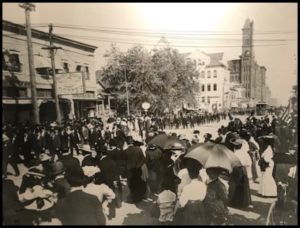
Two years after the ground had been broken, the foundation was completed. The walls were brought up to the level for the main floor and it was time to lay the cornerstone. Sunday, October 6, 1907, was the day set aside for the occasion and no detail was left undone to make the event the most memorable, the most outstanding, and the most unique in the history of the Church in Nebraska.
Newspaper headlines of the day read: “Saint Cecilia’s Cathedral reverently consecrated in the presence of 30,000 people” . . . “10,000 people march in the parade.”
From the World-Herald, “It was a magnificent and imposing army of men, that which marched over the hot pavements from downtown yesterday to the new Saint Cecilia’s Cathedral as a preliminary to the cornerstone laying exercises. It was the greatest religious demonstration of that character which Omaha has ever witnessed or ever may witness. The parade was composed of a body of men two miles long marching six abreast. It was formed on Farnam street between seventeenth and twentieth. As an instance of its length, the head of the procession turned the corner at Thirty-ninth and Davenport streets just as the last body of men which had been standing at rest on twentieth, wheeled into line and took up the sweltering two-mile march.
“One of the most interesting features was the strictly civilian character of the parade. While a few bodies wore the uniform of some society and a few others gave a distinctness to their sections by wearing belts, caps or badges of a uniform in character, the parade as a whole gave the appearance of a great gathering of every-day, middle-class prosperous American citizens. Those who witnessed the parade and made any attempt to estimate its numbers think 10,000 a not too extravagant guess.”
The World-Herald article continues . . . “Each parish and church society carried at its head a banner designating it, and each division of the parade was preceded by a band. The line of march was from Twentieth street on Farnam to Thirty-ninth, thence to fortieth and then directly to the Cathedral. People lined the streets all along the route and comments on the splendid showing were not infrequent.
“At the head of the procession rode a platoon of mounted policemen under the charge of Chief Donahue and Sergeant Hayes. Immediately following were the Knights of Columbus, the Omaha and Council Bluffs lodges, making a total of more than four hundred men.
“The management of the parade was so thoroughly systemized that there wasn’t a hitch in the plans for the formation of the line to the final dispersion of the great civilian forces. As fast as a body of marchers appeared at the rendezvous, it was assigned a position on one of the side streets near Farnam and held there in march formation until its turn. J.A.C. Kennedy, marshall of the day, had as his aids, W.A. Schall, assistant marshall, T.F. Swift, Arthur Coad, A.E. Melady, Dr. F.J. Langdon, Charles Garvey, William Beahr, William Donahue and Fred Hermank.
“As the van approached the new cathedral, the clergy and choir, which had been stationed at the Saint Cecilia parochial school, marched to the reviewing stand. The choir led the way, followed by the monsignors, local and visiting bishops and archdeacons in the ecclesiastical robes. Each bishop had as excort two priests, while the archbishops were accompanied by the lay chairmen of the committee.
“A small stand had been erected for the bishops and archbishops at the Fortieth and Burt corner of the cathedral (near the spot where the altar of the church would stand), and it was from there they reviewed the procession as it rounded the corner and marched to the east end of the new structure where the exercises were held.
“As the marchers approached the reviewing stand they uncovered and remained so until ten feet beyond as a salute to the church dignitaries. From the reviewing stand the procession proceeded to a great vacant common, which had been reserved for them in front of the speakers’ platform where they stood at rest during the ceremonies. The aides and banner carriers were grouped to one side on the platform in a space reserved for them and made a billiant bank of color with all the miltitude of variously tinted flags which they carried.
“The South Omaha societies and parishes marched all the way in and sent up a body of men numbering between 2,700 and 3,000. For the most part they were grouped in one section in the parade.
“Acting as guard of honor to the bishop and his assistants during the ceremonies were eight fourth-degree members of the Knights of Columbus. They were in full dress, earing red, white and gold sashes, and carried drawn swords. The knights thus acting were: C.J. SMyth, T.J. Nolan, Edward D. Geoghegan, J.A. Schall, J.H. Schmidt, Thomas E. Flynn, Frank J. Coad and Edward Kearney.
“State joined with church in giving fitting recognition to the occasion. Representatives of both houses of the national congress, in the persons of United States Senator Norris Brown and Congressman Gilbert M. Hitchcock, participated in the speaking, as did Acting Governor M.R. Hopewell, representing the exective department of the commonwealth in the absence of Governor Sheldon.
“In the ceremonies of laying the stone, Bishop Scannell officiated, the bishop setting the stone with his own hands. Father F.J. Smith of Saint Patricks acted as deacon, Father D.W. Moriarty of Saint Bernards as sub-deacon and Father Flanagan of Saint James orphanage as crossbearer.
“Father Gleason had charge of the music and led the dozen priests who intoned the chants, besides directing the surpliced choir of fifty voices. The choir was a special one made up for the occasion from the choirs of all the churches.
“Archbishop Ireland of Saint Paul delivered the sermon. Senator Brown, Lt. Governor Hopewell, and Congressman Hitchcock each addressed the crowd. T.J. Mahoney, as a representative of the laity, presided over the program.”
Within the cornerstone was put a parchment which reads: On the sixth day of October, in the year of our Lord, one thousand nine hundred and seven, in the fifth year of the reign of our Most Holy Father, Pius X, by Divine Providence Pope, Theodore Roosevelt being President of the United States of American, George Lawson Sheldon, Governor of Nebraska, and James Charles Dahlman, mayor of Omaha, the cornerstone of this cathedral, to be built for the ownership of God under the invocation of Saint Cecilia, virgin and martyr, was laid by the Right Reverend Richard Scannell, Bishop of Omaha. The sermon was preached by the Most Reverend John Ireland, Archbishop of Saint Paul. The architect was Thomas Rogers Kimball; contractors, William Paxton Deverell, Albert Schall and Albert Foll.
Also enclosed were photographs of His Holiness, Pope Pius X, Reverend Richard Scannell, Bishop of Omaha, Fr. William Kelly, who was notable associated with the old cathedral, Saint Philomena, and Fr. Patrick McGovern, the present priest there in charge.
There was also catholic documentary matter from the American Catholic Historical Review of 1891, and the local newspapers, The True Voice, The Omaha Bee, The World Herald, and The News, containing articles about the silver jubilee celebration of Saint Philomena’s cathedral in 1893.
The parade had formed shortly after noon; the services at the cathedral took three hours. A banquet for the hundred visiting prelates, priests, and laymen who participated in the ceremony followed at the Sacred Heart convent. Eating and more speeches continued until the late hours that night.
1959
1959 – Completed Cathedral Consecrated
LEARN MORE
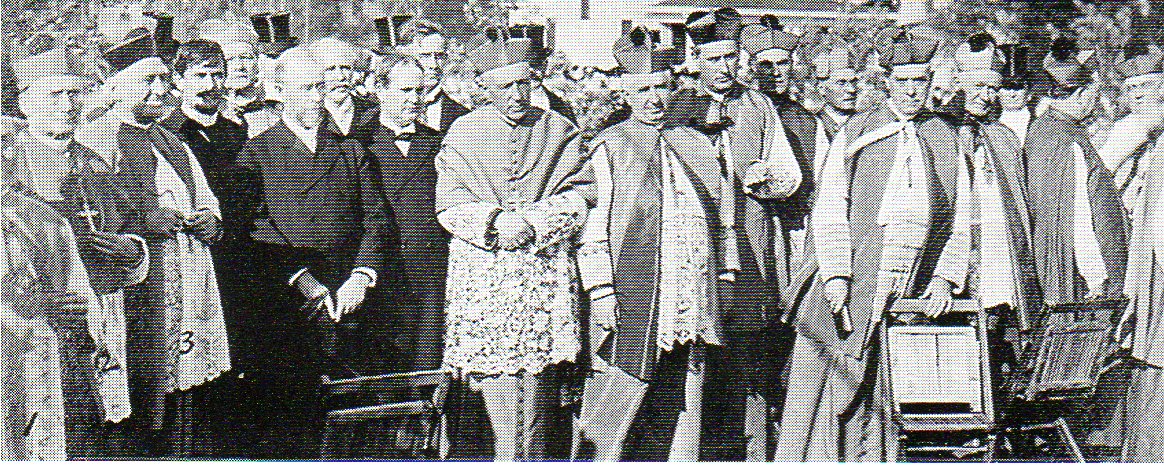
On Thursday, April 9, 1959, Archbishop Gerald T. Bergan and eighty priests consecrated Saint Cecilia Cathedral.
From the evening World Herald, April 9, 1959 . . .
“The ceremony opened at 8:00 am as the Archbishop led the platoon of priests in a procession three times around the outside of the building, sprinkling the walls with holy water. Each time he passed the main doors, Archbishop Bergan knocked as if seeking admittance. The third time, the procession entered chanting the Litany of the Saints, and circled the interior three times, the leader sprinkling holy water on each section of the wall. Following this ceremony, the twelve crosses along the walls were anointed with oil. Each anointing was accompanied by a Latin chant, meaning ‘Let this temple be sanctified and consecrated.'”
The Rev. William Foster served as deacon. Msgr. Daniel E. Sheehan, Chancellor of the Archdiocese, assisted Archbishop Bergan.
This, according to the records, was only the second time in the history of the local Catholic church that a church was consecrated. Archbishop J.J. Harty had consecrated Sacred Heart church in 1922. The ceremony of consecration is performed only when the building is considered complete and debt free. Thenceforth the building can only be used as a church.
Thus is was so — Saint Cecilia’s Cathedral was completed, debt free, and consecrated — a fifty-four year span of time and the aid of over two million dollars in donations. By American standards of progressive ingenuity, taking fifty-four years to build a building would be considered very, very slow. But, in comparison to other cathedrals throughout the world, the building of Omaha’s cathedral was very rapid. Many of Europe’s cathedrals took centuries to construct, some to this day, never completed.
A landmark of towering limestone, impressive with its massive buttresses that can be seen for miles around, the Cathedral of Saint Cecilia now stands tall as a mighty symbol of the living faith of her people. The dream building of five bishops, the nickels, pennies, and dollars of thousands of dedicated men, women, and children is “alive and well.”
1988
1988 – Nighttime illumination added
LEARN MORE
1998-99
1998-1999 – Restoration
LEARN MORE
The 1980s for the American Church was a time of liturgical experimentation and implementation. In the minds of many caring Catholics, formality was associated with distance and coldness. Its opposite, informality, was interpreted as being casual. It seemed necessary to some to apologize for grand buildings and the demands they made upon worshippers. Ceremonies should be accessible, and should be brought to the people. In the 1980s, a movement arose to dole out celebrations and liturgies to parishes rather than to locate them in a cathedral. This movement could often lead to a lack of focus in the philosophy of ecclesiastical procedures.
The late 1980s and the early 90s, however, brought a rediscovery of the longer tradition of the cathedral as being the heart of a city. In the Middle Ages, a cathedral had been the center of the cultural life. Americans, of course, had always been pioneers, striding ever forward to “modern” ways in preference to the old. But contrary to the easy ideas of shallow enthusiasts, serious church leaders once again perceived the wisdom of many Medieval practices.
Archbishop Elden Francis Curtiss loved Omaha’s Cathedral, and major events in the life of the archdiocese returned to Saint Cecilia. Participants in Masses in the largest church in the are sensed the liturgical and civic implications of the structure as the seat of a bishop as high priest. The fullest expression of community in religion would take place at the Cathedral. All of its ministries would be models for daughter churches. From its hilltop location, Saint Cecilia would be a beacon for the Faith. It would impart to the Catholics of Omaha a renewed sense of their being part in a deeply symbolic sense of a “City set on a Hill.”
All this set the stage in the late 1990s for a dramatic physical restoration and renovation program. Things that had been lost would have to be put back. A heritage had to be reclaimed–and proclaimed.
Paul Jeffrey, A.I.A., of the Omaha architectural firm of Bahr, Vermeer and Haecker, led the project. To do so, he said, he would have to “put on the mind of Thomas Rogers Kimball.” He began the renovation with the roof. Frequently allowing rainwater to enter the church, the red Spanish tiles had to be replaced. But where could appropriate replacement tiles be found?
Amazingly, separate strands of Omaha’s architectural history came together just at the right time. Early in the twentieth century, another of the city’s most gifted architects, John Latenser Sr., had built for himself a mansion on a rolling acreage in Ponca Hill, just north of the Omaha city limits. He patterned his house after those he had seen in his native Liechtenstein and roofed it with red tiles. In 1997 the Ponca house had become the headquarters for a new congregation, the Intercessors of the Lamb. They were in the process of renovating it and found that they had red roof tiles to spare. Thus the legacy of Kimball, nearly ninety years after his masterpiece was erected, would be enhanced by materials from the time of one of his (always congenial) competitors in the architectural profession.
Brother William Woeger, F.S.C. served as the “client representative” in the restoration process. Once the roof was restored, the long and challenging task of renovating the interior began. Fortunately, some of Kimball’s original drawings for both the roof and the interior were discovered and could be used as guides. Brother Woeger’s goal was to recapture the richness of the Spanish Renaissance with an Iberian decorative scheme, achieved through the master-craftsmen of the firm of Evergreene Studies of New York City, with the artist Jeff Greene doing most of the work. The clerestory walls were given warm colors to complement the cooler blue of the stained glass windows. Stenciling combined traditional Italian and Moorish patterns with those reflective of the indigenous peoples of New Spain, the Mayans, Incas, and Aztecs. The blue outlines around the stencils especially exhibited the Mayan (Central American) influence.
Nicolette Amundson, A.I.A., with Bahr, Vermeer and Haecker since 1990, directed much of the architectural work of the restoration. Upon the recommendation of Robert Mahoney, an acoustical expert from Colorado, interior ceiling tiles were replaced and plaster was restored on the ceiling vaults.
The renovation occurred under Archbishop Elden Curtiss’ leadership. He was committed to the mission of celebrating the humanities for the Glory of God. The restoration/renovation was unveiled in 2000, a year of pilgrimage in which many hundreds of people from each of the archdiocese’s deaneries came to see what had been achieved with their financial support. It was a common opinion among experts and non-experts alike that Omaha’s Cathedral had become an outstanding venue for the liturgical arts in the United States.
Brother Woeger was the designer of another major contribution to the physical appearance of the Cathedral as its centennial approached. For forty years a rolling, movable altar stood in the sanctuary, symbolically expressing an orientation towards the congregation. This allowed flexibility and adaptation to different ceremonies and varying numbers of celebrants and participants. But it also reflected a kind of architectural uncertainty. A directive from Rome in 2004 declared that a high altar must be permanently placed. This demanded a major change, a difficult effort from one standpoint but a splendid opportunity from another.
Thomas Kimball had designed the original high altar long before the Second Vatican Council, and his original ideas had been sound both liturgically and artistically. Sight lines according to his plan made it possible for worshippers in every part of the Cathedral to focus on the celebrant at the altar. With the rolling, movable altar this had not been so. Now the original focus has been regained, and a new altar designed by Brother William contributes another element of Spanish Baroque magnificence. Its bronze body was fashioned by Omaha artist John Lajba. The baseboards are of Vermont Green marble matching the baseboards of the rest of the church. The altar platform, or pradella, is a white Virginia marble, making a visual connection with the white baldachino. American-quarried Napoleon-grey marble is also used, and the top of the altar is a slab of Rojo Alicante, a marble from Spain.
2002-2005
2002 – Exterior niche statues
2003 – Pasi Organ
2005 – Permanent Mass altar
LEARN MORE
2002 Restoration: Evergreene Architectural Arts
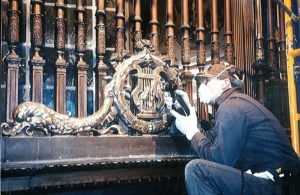
As the nation’s largest specialty contractor of architectural arts, our success is a direct result of dedication to excellence, profound care about our cultural heritage, along with the commitment to always putting quality and craftsmanship first and at the heart of our work.
Architectural art forges deeper connections to the built environment, defining the communities we call home—from the largest cities to the most rural towns. We believe that the work we do enables new ways of how people can experience history and architecture.
Headquartered in New York, with offices in Chicago, Washington DC, and Los Angeles, our multi-disciplinary teams of business developers, conservators, designers, craftspeople, artists, and project managers are ready to collaborate with you on bringing your vision to life.
We were contracted in 2002 to conserve the decorative bronze entrance located at the north entrance aisle in the main sanctuary of the cathedral. The approximately 17’ high x 8’ wide entrance consisted of a combination of cast, extruded, and spun bronze elements with two solid core wooden doors. Decorative stained glass windows set in operable extruded bronze frames provide a backdrop for the metal work and to seal the vestibule off from the interior of the church. The metal portions of the entrance suffered from heavy deposits of floor wax, moderately heavy corrosion deposits, and a white residue possibly from the interior stone cleaning project.
The heavy deposits of floor wax were removed from the bronze using a solvent stripper and plastic scrapers. Loose corrosion products were cleaned using bronze wool, nylon abrasive pads, and soft bronze and plastic scrub brushes. Areas of light green corrosion and bright metal were patinated brown using a cold patina solution to achieve the appropriate tone. All surfaces received a thorough wipe down with toluene and cotton rags to insure that all cleaning compounds, soiling, and the white residue were completely removed. Once all the surfaces were properly cleaned all bronze elements were coated with a lacquer.
1888-2000 TIMELINE
1888: Dedication of Saint Cecilia’s Parish (December 2)
1889: Saint Cecilia’s Parish incorporated (May 5)
1901: Saint Cecilia’s Parish selected to be the Cathedral for the Diocese (May)
1903: Location (40th Street and Burt Street) of Cathedral selected
1904: Plans for the Cathedral approved (May)
1905: Groundbreaking on Saint Cecilia Cathedral (May)
1907: Saint Cecilia Cathedral Cornerstone parade (October 6)
1916: Saint Cecilia Cathedral used for the first time (December 21)
1918: Interior beautification began in the Cathedral
1919: Cathedral main altar installed (April)
1940: High altar with bronze crucifix and marble communion rail installed
1944: Pulpit installed
1945: Omaha diocese elevated to Archdiocese (August 7)
1946: Work on stained glass windows began
1948: Stations of the Cross installed
1951: Windows completed
1952: Dome repainted with Saint Cecilia as the central figure
1958: Twin towers capped with bronze crosses
1958: Consecration and installation of bells (October)
1959: Consecration of Saint Cecilia Cathedral (April 9)
1979: Saint Cecilia Cathedral placed on National Register of Historic Places (January 25)
1979: Saint Cecilia Cathedral honored as a Landmark of the City of Omaha (May 22)
1980: Jubilee celebration
1990’s: Restoration work on Cathedral interior
2000: Restoration and renovation unveiled
Cathedral Tour and Facts
1. Cathedral Plaza / Front Steps
2. Narthex (the space immediately inside the doors)
3. Saint Joseph with the boy Jesus shrine (honoring labor)
4. Saints James the Apostle and Joseph windows (Patron Saints of Bishops Ryan and Rummel)
5. St. Anne, mother of the Blessed Mother, and child Mary alcove
6. Nash Chapel (gift of Catherine Barbeau Nash; crypt below has 38 vaults — 20 of which are filled)
7. Mary and Joseph statues (Polasek sculptures)
8. Ossuary (in narthex niche) Blessed Felix De Andreis Mural
9. Saint Madeleine Sophie Barat window
10. Saints Alphonsus Liguori (left) and Ignatius Loyola window (right), South Clerestory singing windows (back – front: Veni Sancti Spiritus; Pange Lingua; Dies Irae-Dies Illa; Te Deum) and 5 history medallions
11. Antiphonal Choir riser
12. Infant of Prague statue, Saint Frances Cabrini mural (above sacristy doorway)
13. Saint Clare window (ambulatory level)
14-18. Spanish Colonial Collection and 9 Rosary windows
19. Saint Jude shrine (north ambulatory at the gate)
20. Jesuit North American Martyrs mural (above ambulatory), Our Lady of Grace statue (facing nave on cathedral side)
21. Saint Philippine Duchesne mural (above north entry grille)
22. Saints Kateri Tekakwitha (above doors to Nebraska Chapel) and Junipero Serra (opposite wall murals and Augustine Polasek)
23. Our Lady of Nebraska Chapel, Virgin of the Corn (Polasek sculpture) and three stained glass windows from the 16th century Cathedral of Pamplona
24. Baptistry, stained glass windows and sculpture atop baptismal font
25. Saints Benedict (left) and Augustine (right) windows, North Clerestory singing windows (front to back: Magnificat,
Gloria in Excelsis Deo and Stabat Mater)
26. Victimae Paschali and 5 history medallions
27. Saint Euphrasia Pelletier window (ambulatory level)
28. Saints Francis of Assisi (left) and Columban(right) windows
29. Round room with original brick walls
30. Saints Richard and Jeremiah windows (Patron Saints of Bishops Scannell and Harty)
31. Christ the King Shrine (“Your Kingdom Come”)
32. West Gallery, Saint Cecilia Rose window Cathedral Organ by Martin Pasi, Opus 14
33. Bronze Stations of the Cross (Polasek sculpture)
34. Bronze/cararra marble altar rail
35. High Altar Crucifix (Polasek) and wood paneling with statues of the apostles (Polasek – 5 and William Hoppe – 6)
36. Cathedra (Chair)
37. Pulpit with Saints Peter and Paul and Four Doctors of the Church: Saints Jerome, Gregory the Great, Ambrose, Augustine (Polasek)


Cathedral Facts
Depth of the foundation dig: 20 feet
Bell tower footings: 54 feet square at base
Main wall footings at ground level: 8 feet wide
Core of structure: Three-million red bricks
Substructure of roof: 100 tons of steel beams
Kinds of marble used in the cathedral: 12
Exterior stone of the cathedral: Indiana limestone
Bell towers height: 222 feet
Interior ceiling height: 80 feet
Length: 255 feet
Main aisle, narthex to communion railing: 130 feet
Width: 158 feet
Saint Cecilia Rose Window: 25 feet in diameter
Dimensions of high altar crucifix: corpus 7 feet, vertical beam 13 feet, cross beam 6 feet
Cubic feet of interior space: 1,584,000
Seating capacity: 1,020
Monetary contributions for completion of construction:
$2,000,000 + from 1905 – 1959
and more than 30 specifically donated items
More Interesting Information
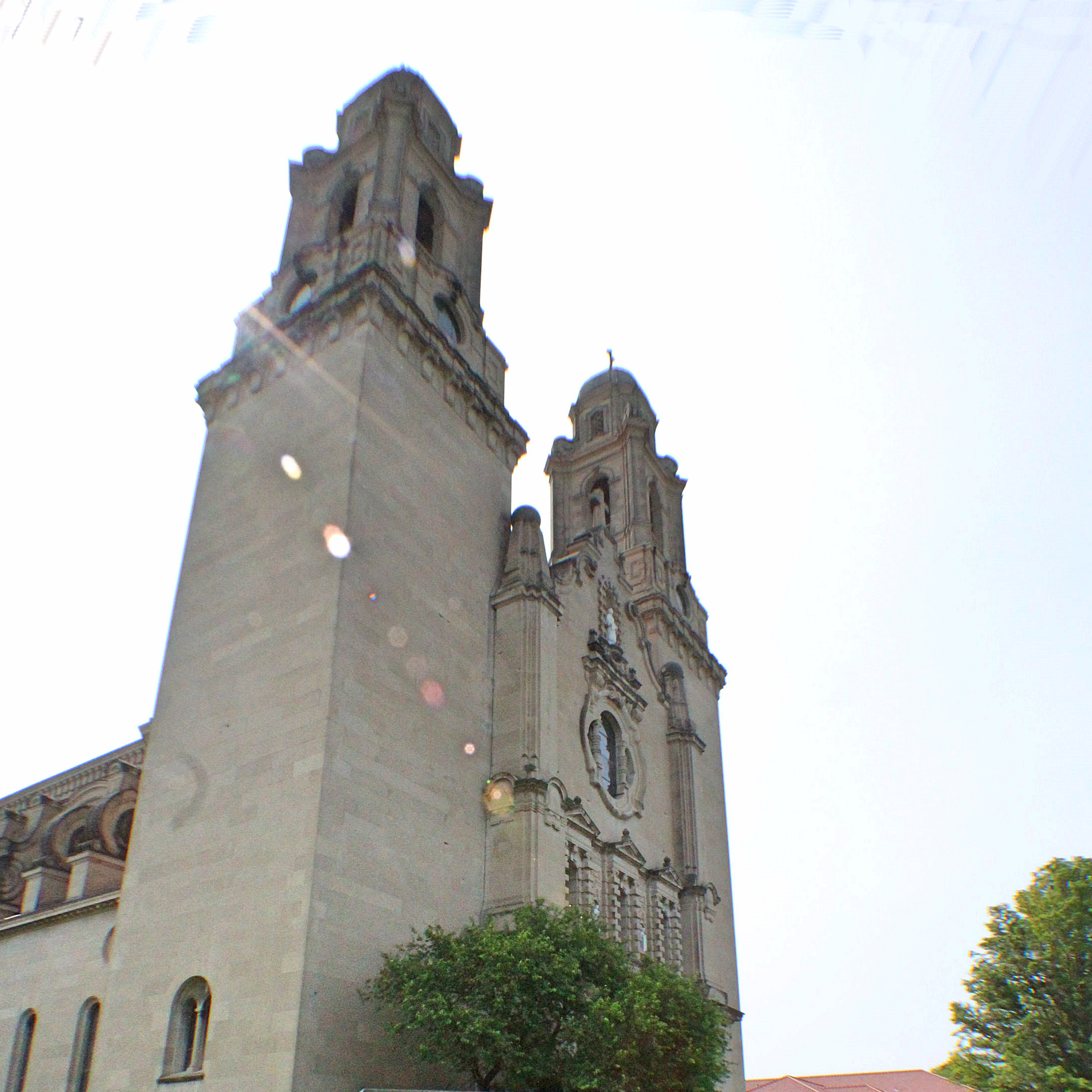
What is a Cathedral?
The word “cathedral” refers to the chair of the bishop, located prominently in the sanctuary of the church. As a successor of the Apostles, the bishop of a diocese leads and guides his people with the Scriptures and Catholic Tradition and through rites of worship for the sake of communion of life with God and with neighbor. Saint Cecilia Cathedral is the second Roman Catholic cathedral in Omaha. Architect Thomas Rogers Kimball conceived the Spanish Renaissance Revival design in an age that belonged to European Gothic designs. Drawing upon Classical and Mexican influences, Kimball created an artistically striking and physically imposing structure that was economically feasible.
Five bishops and five pastors and countless lay people put their minds, hearts and pocket books into the task from 1901 to 1959. The original decoration of the Cathedral was begun at the end of World War II, between 1944 and 1952. The next phase took place 1957 and 1958. A major restoration took place over eighteen months in 1998-99 in anticipation of the Jubilee Year 2000. Br. William Woeger, FSC, was appointed to oversee exterior repairs to the roof and extensive interior restoration and decoration. The result is a stunning recapture and enhancing of the original design intent of Thomas Rogers Kimball, especially with regard to the full effect of music.

Cathedral Visionaries
Richard Scannell was ordained a priest at 26, for the Diocese of Nashville in Tennessee, and first bishop of the Diocese of Concordia, now the Diocese of Salina in Kansas, at 42. In 1891, at age 62, he was appointed bishop of the diocese of Omaha. He would serve three weeks short of twenty-five years. Thomas Rogers Kimball was born in Cincinnati, Ohio, in 1862, and came to Omaha at a young age. He graduated from the Massachusetts Institute of Technology at age 25. He was adventurous and daring but had a decided talent for drawing, with a special flair for the water color medium, for invention and skilled craftsmanship — in writing, in the development of ideas and in aiding the talent of others.
In 1901 Bishop Richard Scannell announced that a new cathedral would be built on the second highest hill west of the city in the Park Place District. The main doors would open to the west and not toward the city below. At that time, the Diocese of Omaha, just 15 years old, covered the entire state of Nebraska above the Platte River – more than 54,000 square miles. Bishop Scannell accepted the request of Thomas Rogers Kimball, 1901, to serve as architect. As a nationally known architect, though resident in Omaha, Kimball created a Spanish Renaissance Revival design and directed its construction until the spring of 1934, when he died suddenly from a burst appendix.
The old cathedral of Saint Philomena, a gothic structure of beauty inside and out, had simply become too small for the booming population of Omaha. The early nineteen hundreds in Omaha experienced a rise in economic tempo and early voluntary contributions allowed for the digging and laying of a foundation to the point of setting a cornerstone in just two and a half years. The tempo slowed, however, after another eighteen months. The bishop appealed for further funds from Catholics beyond the Cathedral parish boundaries. He resorted to an assessment on all the diocese’s ninety five parishes and then took out a loan. There was never quite enough money to finish for the next forty years. Bishop Scannell died in 1916. He saw the “new Cathedral” closed-in but not as a completed edifice. Kimball would continue the project for another 17 years.
The vision and boldness of purpose of these men set a standard which guided their successors to complete the undertaking.
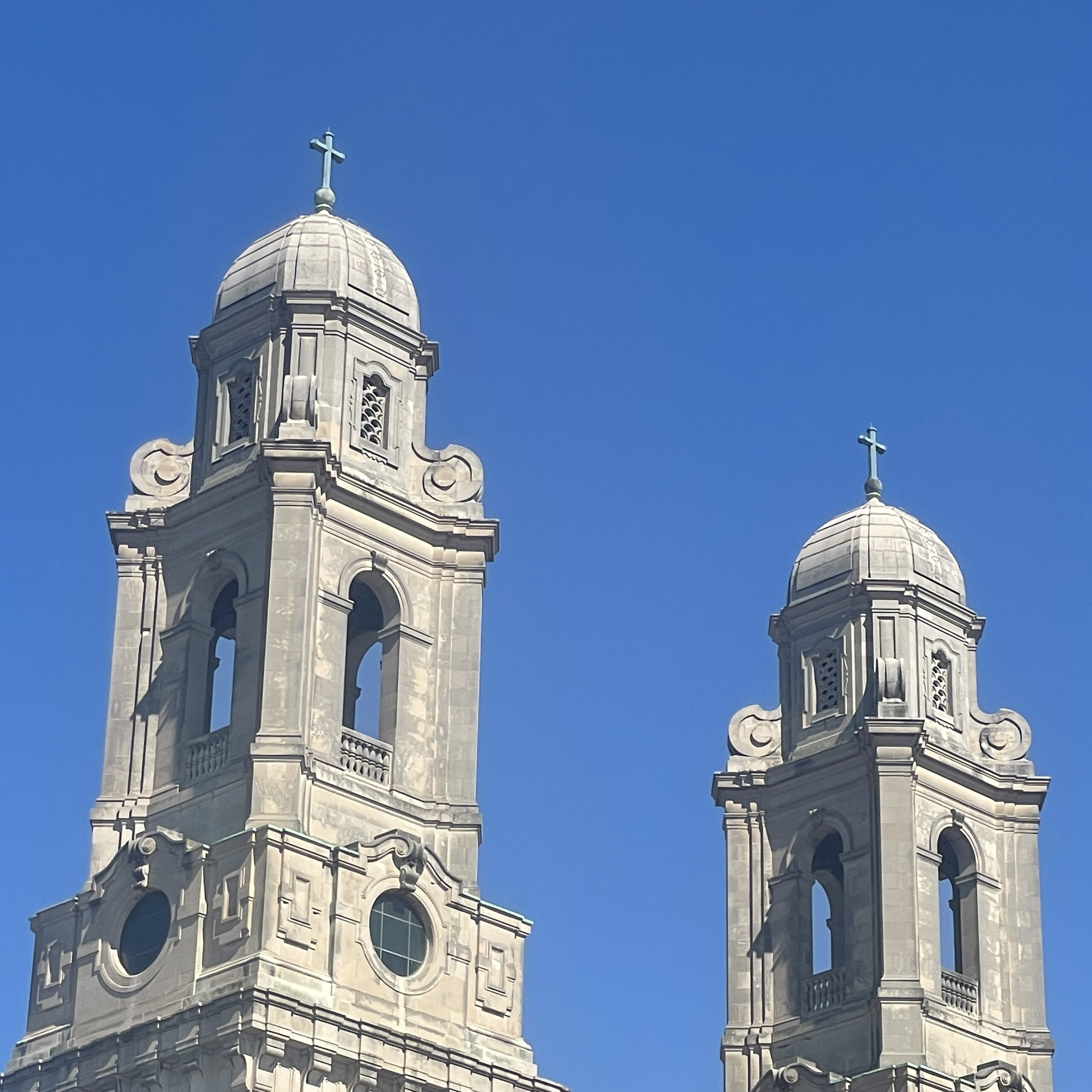
Spanish Renaissance Revival
Inspiration is both ethereal and tangible. There is no specific document or recorded discussion regarding Thomas Rogers Kimball’s decision to employ Spanish Renaissance Revival as the style for the “new” Cathedral in Omaha. Spanish Renaissance Revival was not in evidence, even in the southwest United States, until the 19-teens.
One school of thought holds that the Monastery of San Lorenzo et Real, near the town of El Escorial, Spain, although not a cathedral, provided an inspiration for Kimball’s overall plan. This monastic compound of King Philip II, built between 1563 and 1584 and located approximately 30 miles northwest of Madrid, is a testament to architectural brilliance and Philip II’s renaissance Catholicism.
Another path of study proposes, as more likely, influence of the Spanish Mission architectural style from Mexico and the Southwest United States as the inspiration.
Whatever the actual source of inspiration in Thomas Rogers Kimball, there is no question that the Cathedral of Saint Cecilia is a masterpiece of creativity. It is a cause for pride among parishioners, alumni of the parish schools, and friends among the civic community of Omaha.
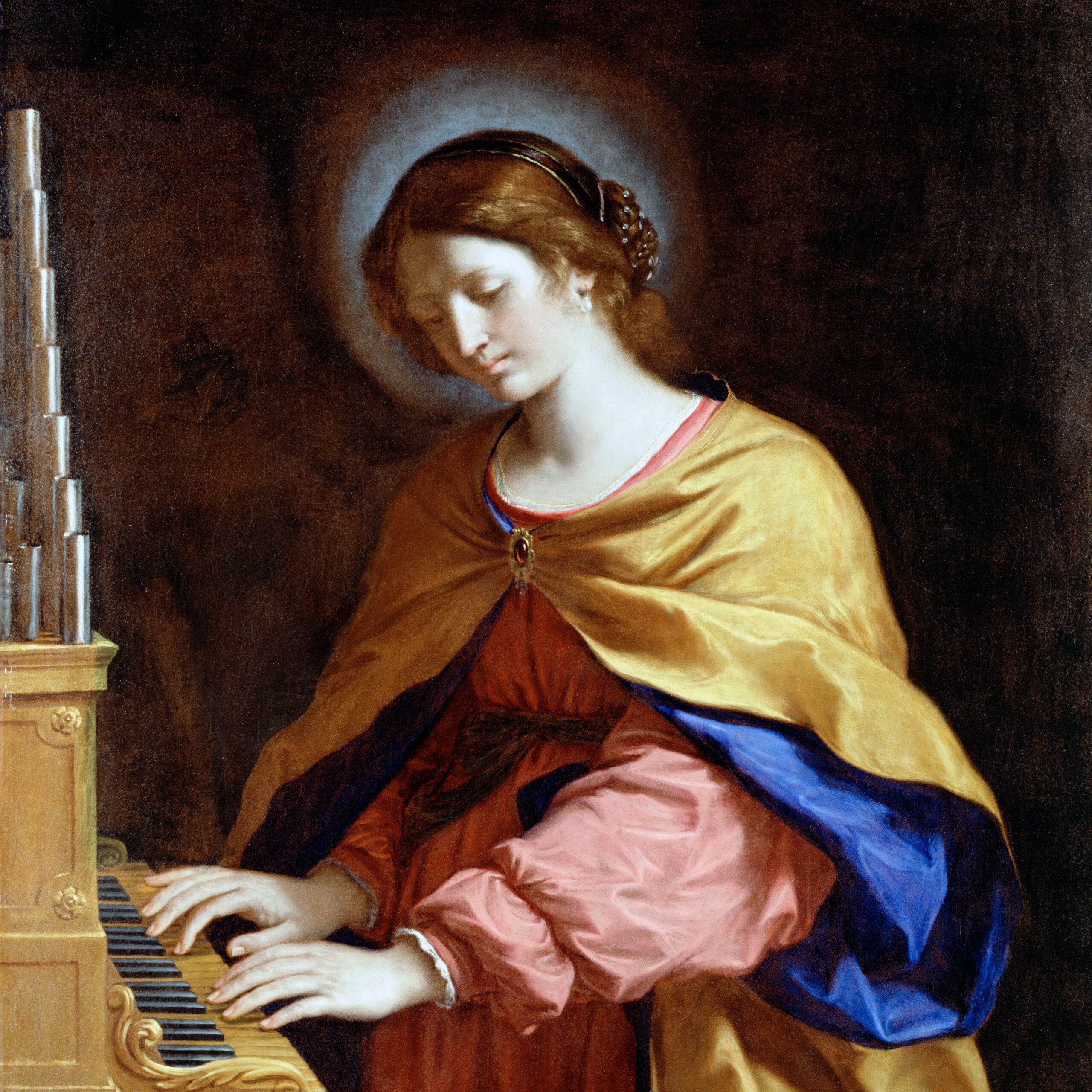
Music and Culture
The patroness of Saint Cecilia Cathedral is a mid third century virgin-martyr. From the early 17th century she has been the patroness of music, especially church music and the organ. The Cathedral Arts Project, a 501c3 corporation, was established in 1986 for the promotion of “Cathedral Culture” through music and the arts. It has a well-earned regional reputation for inviting or sponsoring acclaimed regional, national and internationally recognized individual musicians, choirs and performing groups. There is an annual calendar of performances which attracts seasoned arts patrons and the general public in large numbers.
The Pasi Opus 14 dual temperament organ, inaugurated in 2003, is featured in many performances or is the principal instrument.
The Saint Cecilia Institute for Sacred Liturgy, Music, and the Arts, with offices and studio space on the second floor of the Monsignor Ernest Graham Building, is the musical and teaching arm of the Archdiocese of Omaha Worship Office. The Saint Cecilia Cathedral Choir, in addition to the School of Music which works with more than twenty student and advanced musicians in organ, piano and other instruments annually, demonstrate the commitment to excellence in musical arts as well as fidelity to liturgical tradition of the Church.

Cathedral Arts Collection
Saint Cecilia Cathedral, in addition to its stained glass, sculptures, and paintings, is home to the Spanish Colonial Art collection. These two dozen paintings, figures and statues originated in Mexico, Central America, and northern South America, particularly Peru where the School of Cuzco arose. These items are found in the East Ambulatory, behind the sanctuary, and in the Nash Chapel.
There are 52 stained glass windows throughout the Cathedral. The first 27 windows are the work of the Charles Connick Studios in Boston, Massachusetts. Charles Connick was the dean of stained glass work in the first half of the twentieth century and a champion for the revival of stained glass production in the manner of the medieval artists. The remainder of the windows are the work of Rambusch Decorating Company of New York which completed the interior decoration of the Cathedral in 1958.
These works of craftsmanship and art preach lessons of faith from the heights of the rose window and the eight clerestory “singing windows” to the intimacy of the apsial ambulatory and the simplicity of the sacristy windows. Masterpiece sculpture works in wood, bronze and marble by the Moravian émigré Albin Polasek and his colleague William Hoppe are found throughout the Cathedral.
Above three doorways in the south ambulatory, two doorways in the north ambulatory and facing one another in the north entry are murals by the art deco master Hugo Ulhm depicting the beatified and canonized saints of North America in the nineteenth and early twentieth centuries. At the cornice level in the ambulatories are illuminated lunettes with symbolic presentations of the seven gifts of the Holy Spirit – three on the south side and four on the north side. Also illuminated are the theological virtues given by the Holy Spirit who is at the northwest end. Opposite at the northeast end is Faith, Hope is at the southwest end as an anchor, and opposite at the southeast end is Charity, an inflamed heart.
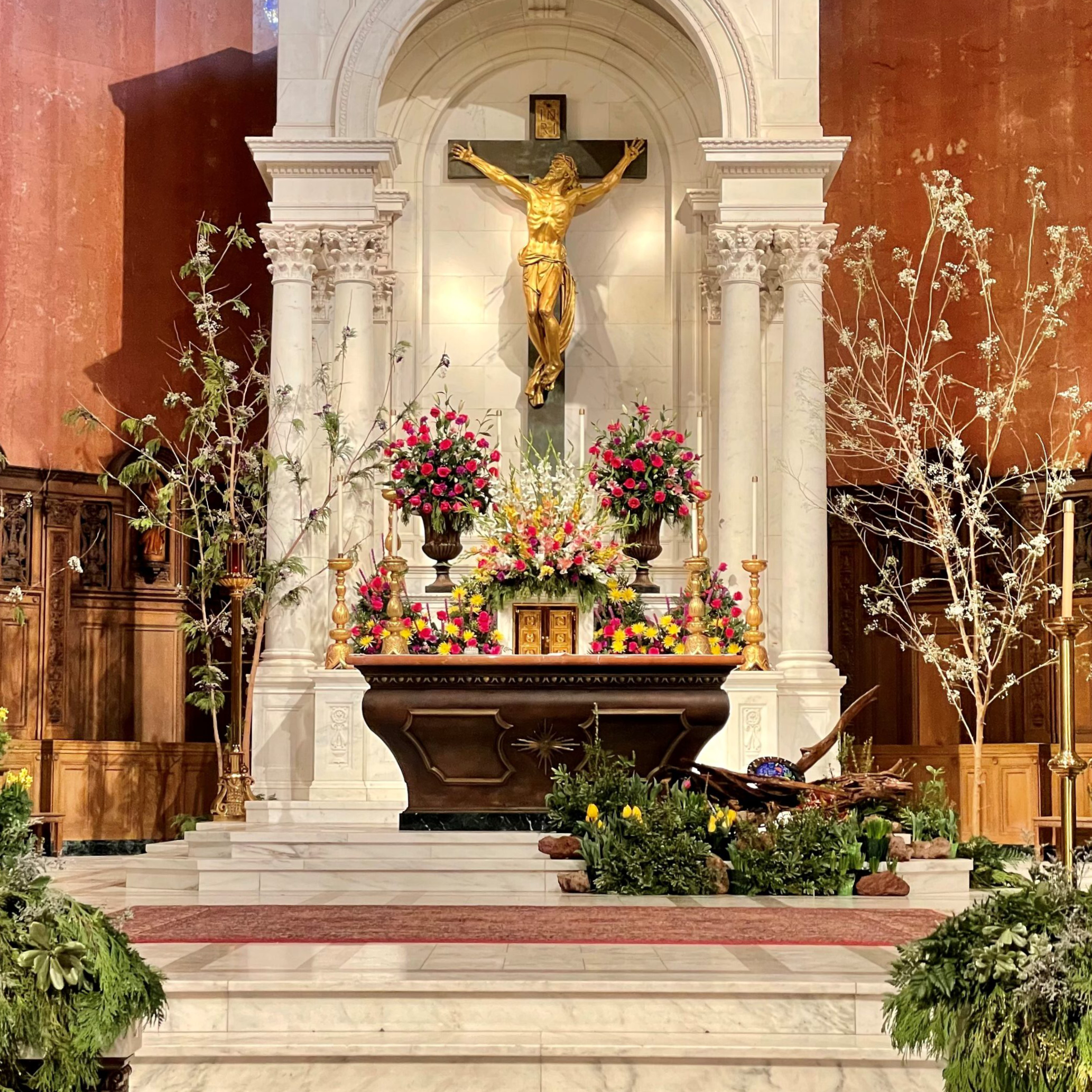
Worship, Word, & Service
The patroness name of Saint Cecilia was a departure from the name of the first church in Omaha, and the first Cathedral, which was Saint Philomena. Saint Cecilia, a Roman virgin martyr in mid third century Rome, was the name given previously to the eighth parish in Omaha in 1888, located northwest of Omaha in the Walnut Hill District.
Saint Cecilia Virgin Martyr Pray for Us (text above the high altar at clerestory)
From its early days as a “pro-cathedral” and then as “the” Cathedral, Saint Cecilia has been an active parish community. Its grade school, continuously functioning since 1907, has an award-winning history of success in the education and Catholic formation of young people. For seventy-five years there was a Cathedral High School, which served as a diocesan high school for nearly 50 years. The parish has a proud history of Faith in action in its outreach to the needy and poor and in its witness for justice and partnerships in the ecumenical and civic community.
For all of its grand architecture and decoration and history, the primary purpose of Saint Cecilia Cathedral is the worship of God. Architect Kimball, although not Catholic, intentionally designed a house of worship. The sacramental and devotional life of the parish, as well as the official liturgies and functions of the Archbishop throughout the year, never cease to manifest the spiritual and religious purpose of this edifice.
The Pastors of St. Cecilia

Reverend Daniel Harrington | 1899 - 1919
Born December 21, 1872 in Eyeries, Ireland. Ordained a priest June 24, 1896. After assignments at Jackson (September), Saint Agnes, Omaha (October) and Kearney, Nebraska (November) in 1898, Fr. Harrington was assigned to Saint Cecilia (not yet the cathedral church) in October, 1899. He died in office on February 4, 1919.

Reverend George Smiskol | 1921 - 1925
Born August 5, 1895 in Chicago. Ordained a priest May 28, 1920. After an assignment as Administrator of Our Lady of Lourdes (Omaha) from September to December, 1921, Fr. Smiskol came to Saint Cecilia (now the cathedral church since 1907) in December, 1921, and served until September, 1925. Subsequent to the Cathedral Fr. Smiskol served as pastor at Saint Charles Borromeo (North Bend) until November 18, 1933 and Our Lady of Lourdes (Omaha) until his death on April 7, 1953.

Reverend James Aherne | 1927 - 1936
Born July 9, 1867 in Ireland. Ordained a priest May 11, 1890, by Bishop Bonacum of the Diocese of Lincoln at Park Place (the residence and chancery of the bishop of Omaha). Fr. Aheme served as pastor in 5 appointments from 1893 (the last of which was 24 years at Saint Agnes in Omaha) until his appointment as pastor of Saint Cecilia in 1927 where he remained until January 30, 1936. Fr. Aherne was made a Domestic Prelate (Monsignor) two years into his pastorate. He would subsequently serve as chaplain at Saint James Orphanage until 1941 and then Notre Dame Motherhouse into the 1940’s. He died December 9, 1955.
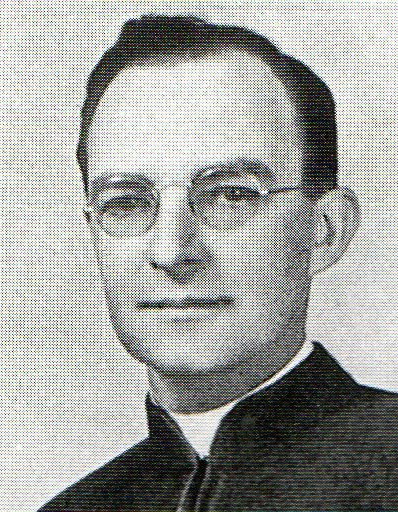
Reverend Edward Hunkeler | 1936 - 1945
Born January 1, 1894, at Medicine Lodge, Kansas. Ordained a priest June 14, 1919. His first assignment was as a pastor in Wynot, NE where he would stay 8 years. Fr. Hunkeler was appointed pastor of the Cathedral on January 30, 1936. He was appointed bishop of the diocese of Grand Island on March 10, 1945 and after that he was installed as the Archbishop of Kansas City in Kansas. Bishop Hunkeler died October 1, 1970.

Reverend Ernest Graham | 1945 - 1968
Born May 19, 1901 at Conception, MO. Ordained a priest June 7, 1927 and was assigned to Saint Cecilia Cathedral from June 30, 1927 to April 7, 1936. Fr. Graham was appointed pastor of Saint Cecilia on April 6, 1945. He served until June 13, 1968. Fr. Graham was the first pastor to have previously served the Cathedral as an assistant priest, in the years June 30, 1927 until July 4, 1936 (pastorates of Aherne and Hunkeler). Upon his departure from the Cathedral Msgr. Graham served as pastor at Saint Patrick (Omaha), June 13, 1968 until June 12, 1970. He lived in residence at Saint Pius X (Omaha) from June 12, 1970 until June 14, 1973. He died November 28, 1975.
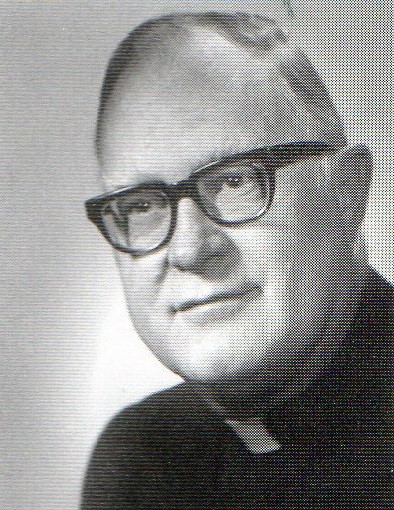
Reverend Edward Schad | 1968 - 1970
Born June 28, 1921 in Newman Grove, Nebraska. Ordained a priest April 4, 1948. Fr. Shad served his second assignment; as an assistant pastor from August 27, 1949 until May 15, 1954. Spending one year at Catholic University of America seeking a degree in education, Fr. Shad returned to Omaha and the Cathedral for a second tour of duty from September, 1955 until June 21, 1958. After a 6 year term as administrator of Archbishop James H. Ryan High School (Omaha) Fr. Schad was a pastor in rural Nebraska before receiving his appointment as pastor of the Cathedral on June 13, 1968. He served until September 30, 1970. Subsequent to the Cathedral, Fr. Schad served as pastor in four parishes before retiring from active ministry on June 16, 1994. He returned to active ministry. In August, 1994, serving as co-pastor of Saint Richard Parish for one year. He retired to the Priest Retirement Residence, 73rd and Shirley Street. He died October 4, 2001.
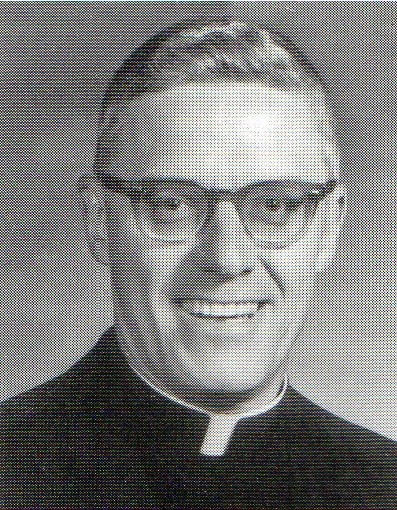
Reverend Paul Peter | 1971 - 1983
Born November 11, 1922 in Omaha. Ordained a priest March 8, 1952 Fr. Peter was assigned to the Cathedral as an assistant from June 21, 1958 to June 15, 1961. Having served as pastor in 4 rural parishes from July, 1961, the last of which was Saint Patrick (Fremont — February 26, 1970) Fr. Peter was appointed pastor of Saint Cecilia on March 30, 1971 and served until June 16, 1983. Subsequent to the Cathedral Fr. Peter served as pastor at Saint Mary’s (0maha) from June 16, 1983 to June 17, 1987, Saint Joseph (Lyons) from June 17, 1987 to June 13, 1990 and Saint Adalbert (Omaha) from June 13, 1990 to December 31, 1994 before retiring. He died October 15, 2000 (the Jubilee year).
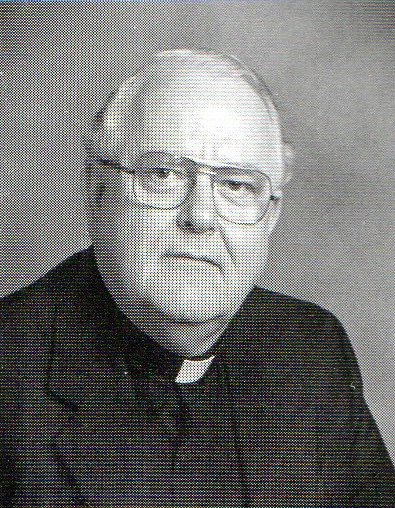
Reverend Martin Conley | 1983 - 1986
Born October 24, 1931 in Omaha. Ordained a priest May 11, 1957. Fr. Conley served his first priestly assignment as an assistant pastor at Saint Cecilia Cathedral from June 1, 1957 to January 17 , 1963. Fr. Conley was serving Sacred Heart Parish (Norfolk) from June 17, 1977 at the time that he was appointed pastor of the Cathedral on June 16, 1983 until June 18, 1986. Subsequent to the Cathedral Fr. Conley served as pastor of Holy Ghost Parish (Omaha) from June 18, 1986 to June 18, 1992, and, at Saint Patrick Church (Tekamah), from June 18, 1992 to June 13, 2002, when he retired from active ministry.
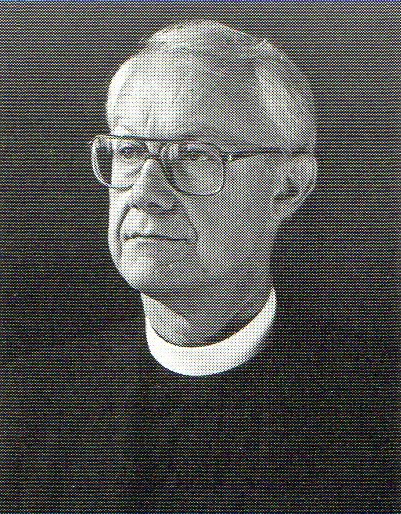
Reverend Vincent Mainelli | 1986 - 1995
Born September 25, 1935 in Omaha. Ordained a priest May 25, 1963. Having served as assistant director and then director of the archdiocesan Catholic Charities from June 15, 1967 to June 15, 1978, Fr. Mainelli was named the founding pastor of Saint Leo Parish (Omaha) from June 15, 1978. Fr. Mainelli was appointed pastor of Saint Cecilia June 18, 1986 and served until June 22, 1995. The parish high school closed at the end of the school year 1993-1994. Fr. Mainelli went to Hawaii to consider membership in the Oratory from June 22, 1995 to April 15, 1998. Upon return to the archdiocese he served as senior associate pastor at Christ the King Parish (Omaha) from July 1, 1998 to June 17, 1999 and pastor of Holy Ghost Parish (Omaha) from June 17, 1999 to October 1, 2000. Fr. Mainelli left active ministry and entered a civil marriage in the fall of 2000.

Reverend Norman Hunke | 1995-2005
Born October 4, 1947 in Snyder, Nebraska. Ordained a priest May 26, 1973. Fr. Hunke served as an associate pastor at Saint Cecilia in his third appointment October 13, 1978 to June 14, 1979. Subsequent to two rural pastorates, Laurel/Dixon and Humphrey, Fr. Hunke was appointed pastor of Saint Cecilia on June 22, 1995 until June 16, 2005. He was appointed the founding pastor of Saint Charles Borromeo Parish in Sarpy County.
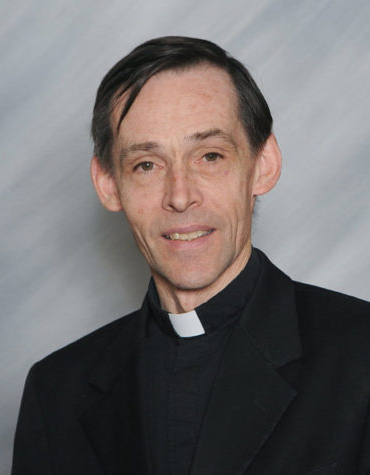
Reverend Michael Gutgsell | 2005 - 2017
Born in Kansas City, Missouri, he came to Omaha in 1961 as an eighth grader in Blessed Sacrament Parish on North 30th Street in Omaha. He has five sisters and four brothers. Six years of minor seminary (four years of high school and two years of college) were taken at Saint John Vianney Minor Seminary, which became Mount Michael High School after his departure. The final years of college and four years of theology took place in Saint Paul, Minnesota. Fr. Gutgsell was ordained at Saint Cecilia Cathedral on May 25, 1974 with eight other classmates. He served in two parishes and, as part of his second parish assignment, taught full time for four of the seven years at Columbus Scotus Central Catholic High School in Columbus, Nebraska. Two years of Canon Law studies at The Catholic University of America, Washington, resulted in a License in Canon Law and an assignment to the Archdiocese Marriage Tribunal. Fr. Gutgsell served full time in the Tribunal from 1983 until 1994 when he was appointed Chancellor of the Archdiocese by Archbishop Elden F. Curtiss. In 1998, in addition to the duties of Chancellor, Fr. Gutgsell was appointed Moderator of the Curia (Chief of Staff among the Directors of the Archdiocesan departments and agencies). In 2003 Fr. Gutgsell, retaining the position of Moderator of the Curia, was named pastor of Saint John the Baptist parish, Fort Calhoun, Nebraska. In 2005 he completed his service at the Chancery. Fr. Michael Gutgsell was appointed pastor of Saint Cecilia parish and rector of Saint Cecilia Cathedral on June 15, 2005. Along with the duties of pastor and rector at the Cathedral, Fr. Gutgsell continued to hold the position of Defender of the Bond for the Second Instance Marriage Tribunal in the Archdiocese. He served as a Judge in the First Instance Marriage Tribunal in the Archdiocese.

Reverend Michael Grewe | 2017-2023
Fr. Michael Grewe became our pastor on July 1, 2017. Fr. Grewe was born in West Point, NE, and attended school in Lyons, NE. His first college years were at the University of Nebraska in Lincoln where he first gave thought to a priestly vocation. From there he went to the College of St. Thomas in St. Paul, MN and later the St. Paul Seminary. He was ordained a priest for the Archdiocese of Omaha on June 2, 1979 here at Saint Cecilia Cathedral. His assignments as an associate pastor included St. Joan of Arc Parish, Omaha; Holy Trinity Parish and Cedar Catholic High School in Hartington, NE; St. John Vianney Parish, Omaha; and Holy Cross Parish, Omaha. Fr. Grewe has been pastor at St. Mary Parish, Laurel and St. Anne Parish, Dixon, including campus ministry work at Wayne State; Holy Ghost Parish, Omaha; St. James Parish, Omaha; St. Patrick Parish, Gretna, and now Saint Cecilia Cathedral. Some highlights of those years were building the new church at St. James and building the new Parish Center and Pre-School at St. Patrick’s. At the Archdiocesan level he is the Executive Director of Catholic Cemeteries and, since the year 2000, Vicar General of the Archdiocese of Omaha. “I am grateful for all the people who have been so supportive of me all these years. I am blessed with a wonderful extended family and with great friendships among our priests – especially with my own priest support group – six of us who meet together every month for a full day of prayer and mutual support. I am so grateful to Almighty God for the gift of my vocation. It has been the greatest blessing of my life.”
School History
Some 30,000 people watched the dedication and laying of the cornerstone for Saint Cecilia Cathedral on October 6, 1907. The very next day Saint Cecilia Grade School opened for the first time! Five determined Sinsinawa Dominicans nuns from Wisconsin made up the first faculty. The sisters lay the foundation for what would become a century of excellence, equipping Saint Cecilia children with an education at once rooted in the Catholic faith and competitive in the wider world.
Our Dominican Tradition
To contemplate, and give to others the fruit of your contemplation.
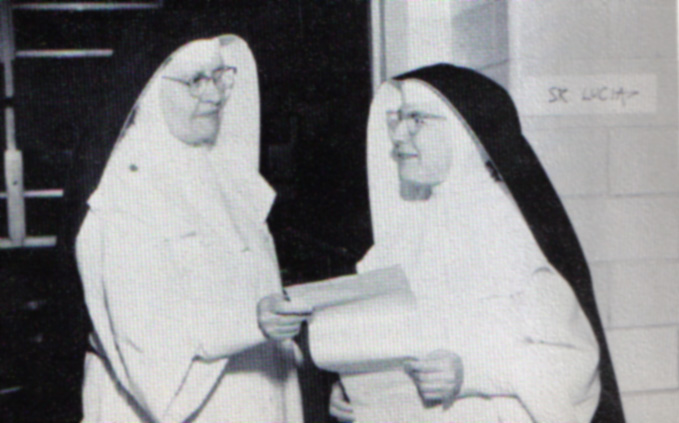
We celebrate over 100 years at Saint Cecilia Cathedral Grade School and we are the longest running, continuously operating grade school in the Omaha Archdiocese. Our Dominican founders nourished the roots of our students from the very beginning. But more than simply teaching the skills of writing, reading, and arithmetic, teachers made certain that we were staked like young trees, to grow straight and strong in a moral way-—to mature into adults who could make the right choices. Green, wet wood will eventually burn. And if nurtured and tended long enough that wood may at some future time warm and light the way for others.
Some 30,000 people watched the dedication and laying of the cornerstone for Saint Cecilia Cathedral on October 6, 1907. The very next day Saint Cecilia Grade School opened for the first time!
Five determined Sinsinawa Dominicans nuns from Wisconsin made up the first faculty. The school occupied a two-story building near the Cathedral construction site. But there are only enough students and teachers for four classrooms. The teachers were: Sr. M. Dionysius Hurley, first and second grades; Sr. M. Donata Wohl, third and fourth grades; Sr. M. Olivia Moran, fifth and sixth grades; Sr. M. Cecilia Renn, seventh and eighth grades; and Sr. M. Celeste Hurley, music.
Even as the Cathedral rose, the sisters lay the foundation for what would become a century of excellence, equipping Saint Cecilia children with an education at once rooted in the Catholic faith and competitive in the wider world. This fits the Dominican motto: To contemplate, and give to others the fruit of your contemplation.
Saint Cecilia graduated its first grade school class in 1908. And so began our great story . . .
